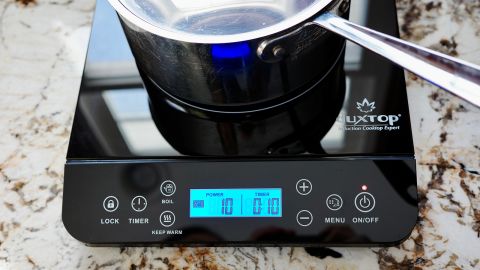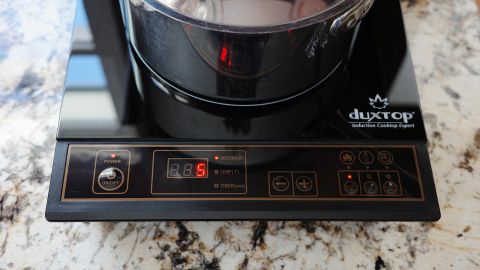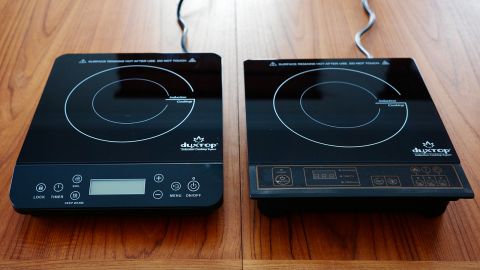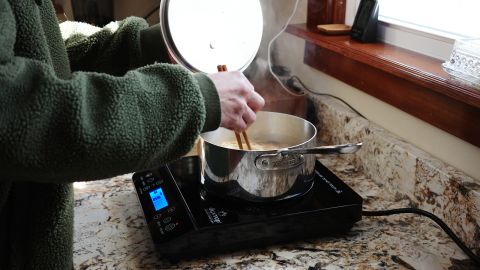Long the go-to option for recipe demonstrators, food vendors, dorm room cooks and even professional chefs, a portable induction cooktop is more than just a simple hot plate. These single-burner devices come in handy even in the best-equipped kitchen. Whether you’re experimenting with induction, looking for a tabletop device for family hotpot nights, or need extra cooking space at the holidays, induction burners are a convenient way to increase your kitchen’s cooking capacity quickly and efficiently.
To find the best portable induction cooktops for your kitchen, we spent the depths of winter preparing classic meals like french onion soup and beef bourguignon on a handful of different models to find the best options.
$116.96 at Amazon

The Duxtop 9600LS Portable Induction Cooktop was the best all around induction burner we tried. It excelled on our cooking tests, handling a variety of tasks with ease. Since an induction cooktop can heat pans directly and efficiently via electromagnetism it can get up to temperature much faster than a flame or traditional electric burner, and the Duxtop 9600LS got up to temperature the most quickly (and held that temperature more accurately) than the competition. It cooked just as well as our brand new LG electric electric range, but in a fraction of the time.
The Duxtop 9600LS was the top-performing burner in our cooking tests. With 1800 watts of power, and temperature settings ranging from 130 degrees to 460 degrees, the 9600LS handled every ingredient and task we tested well. It boiled two quarts of water in 4 minutes, quicker than some cooktops which took upwards of 5 minutes to reach a full boil. The 9600LS burner also gently sauteed onions, caramelizing them perfectly, rather than blackening or charring, as happened with the other cooktops we tested. At the highest heat setting, the 9600LS also beautifully browned a beef chuck roast in a cast iron skillet.
The 9600LS is compact — about 11.5-inches wide by 14-inches deep — and suited even to cramped kitchens, and its design is clean and functional, with a responsive, easy-to-read angled control panel that enabled us to make the most of this burner’s cooking capabilities. You can adjust the burner’s output by either power level or temperature; we found it easier to maintain a steady simmer using the power settings (rather than temperature selection). A child safety lock, timer, boil and keep warm settings round out the selection of useful features.
The only issue we encountered was the high-pitched whine common to induction cooktops when used with certain cookware. This was actually less severe with the 9600LS than with the other cooktops we tested, so a point in its favor if you are sensitive to the sound.
$56.99 at Amazon

The Duxtop 8100MC is a great alternative for the occasional user, someone on a budget, or people tight on space. For around half the cost of the 9600LS, the Duxtop 8100MC cooks nearly as well, browning meat, sauteing onions and holding a simmer better than the competition. It even brought water to a boil faster than its bigger sibling, in around 3.5 minutes.
The 8100MC is slightly more compact than the 9600LS (it’s about an inch shorter in depth), and has a similarly intuitive design, though the aesthetics are a bit less slick and the display more minimal. Like the 9600LS, the 8100MC lets you adjust settings by temperature or power level, though those settings are not as granular, spaced in increments of 40º F rather than 20ºF as on the 9600LS — even more so than with the higher-end model, we found it easier to stick to adjusting the burner output by power instead.
The 8100MC also has a timer function, but it lacks a child lock or presets for boiling water and similar common uses. That said, the lack of presets didn’t feel like a dealbreaker, because it’s still possible to simply set the burner on low (or high) and maintain a constant temperature regardless of having a specialized button for it. We liked the 8100MC’s tactile buttons, by the way, which were a pleasure to use.
As with the 9600LS and the rest of the cooktops we tested, the Duxtop 8100MC produced a whine when in use, but again we didn’t find that to be a dealbreaker.
What to know about cooking with induction

Induction cooktops work very differently from the electric or gas ranges you might be familiar with, and their advantages over both traditional technologies make them a great addition to your meal prep routine. Rather than transferring energy by thermal conduction to your pots and pans (which is what’s happening when you use a flame or an electric coil), an induction burner heats the pan directly via electrical induction.
An induction burner works by passing a rapidly oscillating current through a coil of wire located under the burner surface. This creates a magnetic field (you probably remember this from experimenting with electromagnets in school) and the current (which is alternating at a high frequency) produces an eddy current in a pan placed atop the coil; resistance within the pan then creates heat.
For this to happen, the pan has to be made of a ferrous material, which is why aluminum and copper cookware don’t work on induction surfaces. Cast iron and most stainless steel cookware should work fine; a good way to test is by bringing a small magnet with you when you’re shopping for cookware — if a magnet sticks to the bottom of a pan you’re interested in, it will work on an induction cooktop. Luckily, the great majority of high quality cookware we’ve tested recently, from dutch ovens and cast iron skillets to nonstick pans, is induction compatible, and manufacturers, recognizing the interest in the technology, have been making compatibility clear in packaging and labeling.
The benefits of induction are many (you can find a nice write-up on the finer points of induction over at Fine Cooking). Induction burners are at least twice as fast as gas or electric burners for most tasks. Since induction doesn’t depend on transferring thermal energy, induction burners are both comfortable to work in front of and very safe — only the pan itself is heated during cooking so there’s no residual heat and the burner’s surface remains relatively cool. And there’s of course no environmental risk or climate impact, as there is with gas burners.
Single burner portable induction cooktops are a great way to experiment with the technology if you’re considering swapping out your gas or electric stove, or to incorporate it into your routine if you rent and don’t have that option. About the footprint of a food processor, they’re great for temporarily adding additional capacity to your kitchen for the holidays or for family meals like hotpot that require a heat source at the table (since they’re cool to to the touch, they’re a lot safer than traditional electric hotplates — and they’re superior performers too), and they’re easy to keep clean and to store away when not in use.
An issue common to induction burners — and we encountered it to some extent on every burner we tested —was that they tend to emit a high-pitched whine, whistling, rattling or humming sound when pots or pans are on the activated burner. Although the sound was annoying to us, some people are more sensitive to it than others and your mileage may vary. Either way, it is not cause for concern or the result of a defective burner.
The whining noise is more pronounced at high-heat settings, in lightweight pans, or pans smaller than the burner coils, or in pans with little food, Heavier cookware (like cast-iron pans) can mitigate it somewhat, as can always making sure to choose pans that fully cover the burner area.
How we tested

We tested each induction burner with an array of simple, but standard cooking tasks, noting which models performed especially well or poorly, and if there were any design issues that impacted functionality. We assessed the burners across a range of criteria:
We tested how well the burners sauteed onions, noting whether they caramelized or if they started browning and burning. We also tested the high-heat searing abilities of the burners, by browning large chunks of chuck roast for a beef bourguignon. And finally, we did a couple simple tests to see how quickly the burners were able to boil water, and subsequently, if they were able to consistently hold a simmer.
Out of the box, we noted things like preset cooking functions, the size of each burner, and quality of construction. We also paid attention to any useful features like a child safety look or cooking timer. If any burners beeped when making setting selections, or when the timer was up, we also took note of that. Finally, we noted how tactile the buttons were, and if any were especially unresponsive. Some burners only had membrane control panels, while others had physical buttons and switches.
Other induction cooktops we tested
iSiLER’s Portable Induction Cooktop
$69.95 at Amazon
iSiLER’s Portable Induction Cooktop was a close second to the two Duxtop cooktops we recommend. This burner’s large footprint — it’s about an inch deeper than the Duxtorp 9600LS)––is what ultimately pushed it out of contention. If you have a lot of counter space, this burner worked as well as our main recommendations, but in my small Brooklyn apartment, that extra depth meant it was harder to use and store.
Max Burton 6400 Digital Choice Induction Cooktop
$103 at Amazon
The popular and affordable Max Burton 6400 Digital Choice Induction Cooktop has an attractive look, with an angled display that makes setting the burner simple. We ultimately dismissed this burner because its heat settings weren’t granular enough to maintain a simmer—we could get water to boil or or entirely still. It also has a higher pitched whine than others, which was difficult to tolerate, and burnt onions rather than nicely caramelizing them.
NuWave PIC FLEX Precision Induction Cooktop
$69.99 at Amazon
The NuWave PIC FLEX Precision Induction Cooktop has a bunch of great features, like heat settings with the appropriate cooking style (boil, sear, simmer, etc.) listed, and no noticeable whine at any setting. But the NuWave only lets you adjust temperature incrementally (though in relatively fine increments of 10º F), offering only low, medium, and high power selections (we much preferred models that let us fine-tune burner output by both power and temperature). It was the only burner that didn’t have a power off button, which we found inconvenient, and it lacked a child safety lock.
Zavor Pro Portable Induction Cooktop
$199.95 $129.95 at Sur La Table
The Zavor Pro Portable Induction Cooktop works well, and offers a lot of functionality, like numerous preset cooking settings. If you’re highly sensitive to noise, this burner might be a good choice, as we didn’t notice a whining sound when using this model. However, the Zavor has the largest footprint of the models we tested, was more expensive than most induction cooktops (costing well over $100, even on sale), and its heat settings are incrementally adjustable only by temperature, not by power level, which we missed when trying to hold a simmer.
Aobosi Induction Hob
$55.99 at Iaobosi
The design of the Aobosi Induction Hob is visually appealing, and it’s a steal for around $56, but we found the buttons tough to use, and it was unable to consistently maintain a simmer.
Source: www.cnn.com


